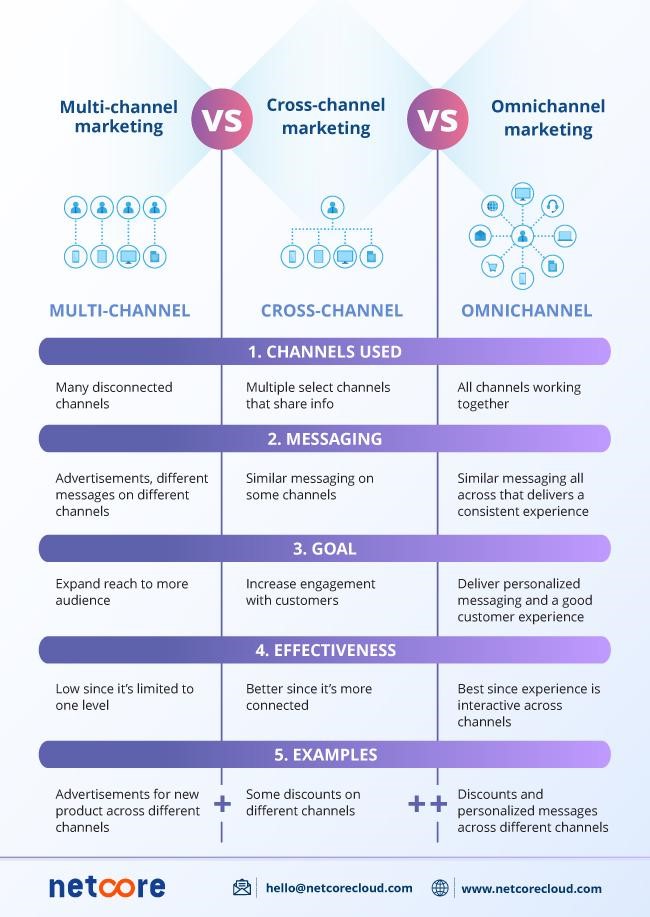Cross‑channel marketing is all about meeting people where they are—on email, social media, your website, even a text message—and giving them a cohesive brand experience. By coordinating messaging across multiple channels, we can guide prospects through every stage of the customer journey, from first impression to loyal repeat buyer.
I’ve been in marketing long enough to see tactics come and go, but one thing hasn’t changed: people don’t live in a single channel. They scroll Instagram, check email, read blogs, and sometimes—gasp!—still answer the phone. When I started tying those channels together instead of treating them separately, my campaigns stopped feeling like a scattershot and started to look like, well, actual journeys. In this article I’ll share how you can do the same.
What Is Cross‑Channel Marketing?
Cross‑channel marketing is the practice of delivering coordinated messages across multiple marketing channels (email, social, SMS, ads, etc.) to create a unified customer experience.
When people ask me what cross‑channel marketing means, I like to compare it to hosting a dinner party. If each guest only gets served in one room, they’ll have very different experiences. When you invite everyone into the same conversation (and serve the same delicious food), you create a sense of unity. In marketing terms, that means your blog post, follow‑up email, Instagram ad, and SMS reminder all tell the same story. Rather than just pushing content through separate channels, you connect the dots, allowing customers to pick up where they left off regardless of which platform they’re using.
This approach differs from multichannel marketing (where you use multiple channels without coordination) and omnichannel marketing (which strives for a seamless experience but often focuses on physical and digital integration). Cross‑channel marketing is about making sure every touchpoint works together toward the same outcome. The result? A more cohesive brand journey, higher engagement, and better conversions.

Key Principles of Effective Cross‑Channel Marketing
Great cross‑channel campaigns are built on a unified customer experience, integrated data, coordinated channel execution, and thoughtful personalization.
Let’s break the principles of cross‑channel marketing below:
1. Data Integration
- Summary: All your customer data needs to live in one place.
- Details: Data is the lifeblood of personalization. If your email list doesn’t talk to your CRM or your ad platform, you’ll end up sending irrelevant messages. A customer data platform (CDP) or integrated CRM gathers interactions from all channels—website behavior, email clicks, purchases—so you can see a 360° view of each customer. With integrated data, you can trigger actions based on real behavior (e.g., sending a discount after a cart abandonment) rather than guesswork.
2. Channel Coordination
- Summary: Timing and sequencing across channels matter.
- Details: Cross‑channel isn’t about blasting every message everywhere at once. It’s about orchestrating a sequence. For example, someone downloads an eBook, then receives a thank‑you email, followed a day later by a LinkedIn ad that relates to the eBook topic, followed by a personalized call invitation. Mapping the journey ensures that each touchpoint builds on the previous one instead of competing. Use automation tools to schedule and stagger messages appropriately.
3. Personalization
- Summary: Tailor content to individuals, not segments.
- Details: Personalization goes beyond addressing someone by name. Use the data you collected to tailor offers, recommendations, and timing. If a customer browses a particular product category, show them related items across channels. If they are a first‑time visitor, don’t bombard them with high‑commitment offers. You can use dynamic content blocks in emails, personalized ads based on behavior, and even text messages triggered by specific actions. The more relevant your message, the more likely it will resonate.
Benefits of Cross‑Channel Marketing Campaigns
Coordinated campaigns enhance customer engagement, boost conversions, improve attribution, and create stronger brand loyalty.
When my team started adopting cross‑channel campaigns, the results spoke for themselves. Instead of seeing isolated spikes of engagement, we watched metrics lift across the board. Here’s why:
- Improved Engagement and Retention
Customers who see consistent, relevant messaging across channels feel understood. They’re more likely to open emails, click ads, and stay subscribed. This trust reduces churn and increases lifetime value. - Higher Conversion Rates
A single channel might draw attention, but repeated exposure in different contexts drives action. A prospect might ignore your email but later click a retargeting ad because the offer feels familiar. The combined effect nudges them along the funnel. - Better Attribution and Insights
With integrated data, you can see which channels contribute to conversions. This helps you allocate budget more effectively. For example, you may discover that Facebook ads prime users who later convert via email. - Stronger Brand Loyalty
A seamless journey feels like a concierge service. When people don’t have to restart or reenter information as they move between channels, they trust you more. That trust translates to referrals and repeat purchases.
Developing a Cross‑Channel Marketing Strategy
Build your strategy by understanding your audience, choosing the right channels, and mapping content to each stage of the funnel.
Here’s how I approach cross‑channel marketing strategy development:
Audience Segmentation
- Create customer personas using demographics, behavior, and psychographics.
- Segment lists based on lifecycle stage, purchase history and engagement level.
- The more specific your segments, the more tailored your messaging can be.
Channel Selection
- Identify where your audience spends time. Younger audiences might respond better to TikTok or Instagram; B2B buyers may prefer LinkedIn and email.
- Prioritize channels that complement each other—for example, pairing email with push notifications or remarketing ads with social.
- Consider resource constraints; it’s better to do a few channels well than many channels poorly.
Content Mapping
- Align content types to funnel stages. At the top of the funnel, focus on awareness through blog posts, videos, and social content. In the middle, nurture interest with webinars, whitepapers, and email sequences. At the bottom, use case studies, testimonials, and demos to convert.
- Plan how each piece of content links to the next touchpoint, creating a narrative that guides the reader toward a desired action.
- Use a spreadsheet or journey mapping tool to visualize the flow.
Building a Cross‑Channel Campaign That Converts Across the Funnel
Coordinate touchpoints across the customer journey by sequencing channel‑specific actions for awareness, consideration, conversion, and loyalty.
Let’s walk through a cross‑channel campaign I ran last year for a software launch:
Top of the Funnel (Awareness)
- Hook potential customers with valuable, channel‑tailored content.
- We published a blog post on a trending pain point and promoted it with paid social ads. We also repurposed highlights into short LinkedIn videos and Instagram stories. The goal was to spark interest without asking for anything in return.
Middle of the Funnel (Consideration)
- Nurture leads and demonstrate authority.
- When readers downloaded an eBook from the blog, they triggered an automated email series (three emails over a week) that expanded on the topic and introduced our solution. At the same time, we created a retargeting audience from landing page visitors and showed them remarketing ads with testimonials. These ads reminded them of the next step: a free webinar.
Bottom of the Funnel (Conversion)
- Make it easy to buy and reduce friction.
- During the webinar, we offered a live demo. Attendees received an SMS reminder one hour before the start time. After the demo, we sent personalized follow‑up emails with a limited‑time discount and a “Book a call” button. Prospects who hadn’t opened the emails saw a retargeting ad with a countdown timer, creating urgency.
Post‑Purchase / Loyalty
- Keep the conversation going and encourage advocacy.
- New customers entered an onboarding sequence via email and in‑app messages with tips on how to use the product effectively. We invited them to join our private community, where we shared exclusive content. A month later, we asked for feedback and encouraged them to share their success stories on social media.
By coordinating these touchpoints, we guided our audience smoothly from awareness to conversion without overwhelming them.
Cross-Channel Marketing Examples That Inspire
Real brands combine multiple channels—email, social, SMS, ads, and offline—to create coordinated experiences that drive results.
Here are a few cross‑channel marketing examples to spark ideas:
- Ecommerce Flash Sale
- Scenario: A clothing retailer runs a 48‑hour sale.
- Channels used: Instagram teaser posts build anticipation. An email campaign goes to VIP customers with an early access link. SMS reminders notify subscribers when the sale starts. Remarketing ads target website visitors who didn’t buy. In‑store signage and push notifications through the retailer’s app tie the online and offline experience together.
- Result: Coordinated messaging creates urgency and keeps the sale top‑of‑mind.
- SaaS Product Launch
- Scenario: A B2B company releases a new analytics feature.
- Channels used: Blog posts educate prospects on the value of data-driven decisions. A webinar invites sign‑ups via LinkedIn ads, email, and community forums. Post‑webinar nurture emails deliver additional resources. Account‑based marketing emails and LinkedIn InMails target high‑value leads.
- Result: Unified narrative across channels positions the company as a thought leader and generates qualified leads.
- Local Event Promotion|
- Scenario: A fitness studio hosts a charity workout class.
- Channels used: Flyers distributed in local cafés and gyms, Facebook event page invites, Instagram stories with countdown stickers, email newsletters to members and neighborhood email lists, plus text messages the day before the event.
- Result: Combining digital and physical touchpoints boosts attendance and community engagement.
Each example shows how different channels can work together without feeling repetitive. The common thread is a clear objective and coordinated messaging.
Tools and Platforms for Cross‑Channel Orchestration
Use marketing automation and customer data platforms to manage campaigns, integrate data, and trigger actions across channels.
If the thought of juggling emails, ads, SMS, and push notifications makes your head spin, you’re not alone. Fortunately, there are tools designed to orchestrate cross‑channel campaigns:
- Marketing Automation Platforms (MAPs): Tools like HubSpot, ActiveCampaign, and Marketo allow you to build workflows that send emails, update CRM fields, and trigger ads based on user behavior. They often include drag‑and‑drop journey builders so you can visualize the flow. Netcore’s customer engagement platform is one of the leaders in the Martech industry for an easy-to-use platform with unified dashboards for effective cross-channel engagement.
- Customer Data Platforms (CDPs): Platforms like Segment, RudderStack, or Adobe Experience Platform collect and unify data across touchpoints. They integrate with your MAP, ad networks, and analytics tools, ensuring that a click on an email can trigger an ad suppression or that a purchase stops a nurture sequence.
- SMS and Push Notification Services: Tools like Twilio, OneSignal, and Pusher make it easy to send timely messages beyond email. They integrate with MAPs and CDPs, enabling you to trigger a text when a cart is abandoned or a push when a new blog post goes live.
- Analytics and Attribution Tools: Google Analytics, Mixpanel, and Amplitude help track user journeys across channels. Multi‑touch attribution models show how each channel contributes to conversions, giving you data to fine‑tune your strategy.
Most successful cross‑channel marketers use a combination of these tools. The key is integration: choose platforms that connect well with each other to avoid data silos and duplicate work.
How to Launch a Successful Cross-Channel Marketing Campaign
Track performance across channels, look for patterns, and test improvements iteratively.
I’m a firm believer in the mantra, management expert Peter Drucker once said, ‘What gets measured gets managed.’ Here’s how to keep your finger on the pulse of a cross‑channel marketing campaign:
- Define Success Metrics: Set specific goals for each stage of the funnel—open rates and click‑through rates at the top, webinar attendance and reply rates in the middle, conversion rates and revenue at the bottom. Also monitor long‑term metrics like customer lifetime value (CLV) and churn.
- Use Multi‑Touch Attribution: Assign credit to multiple interactions (e.g., first‑click, last‑click, linear models) to understand how channels work together. This helps prevent the mistake of attributing all success to the final email when ads and webinars did much of the heavy lifting.
- Analyze Engagement Patterns: Look at which channels drive the most engaged users. For example, you might find that leads who attended a webinar are twice as likely to convert compared to those who only read the blog.
- Test and Iterate: Run A/B tests on subject lines, ad creative, SMS timing, and landing page layouts. Document your hypotheses and results. Even small improvements add up over time.
- Review and Refine Segments: Periodically revisit your segmentation. As you gather more data, you might discover new clusters of users or behaviors that warrant specialized messaging.
By measuring what matters and acting on insights, you can refine your cross‑channel strategy and improve ROI with each campaign.

Watch the insightful webinar on demand here.
Common Challenges of Cross-Channel Marketing
Typical obstacles include data silos, message fatigue, privacy compliance, and internal misalignment—but they’re solvable with planning.
Every marketer faces hurdles when orchestrating cross‑channel campaigns. Here’s how I tackle the big ones:
- Data Silos and Integration Issues
- Challenge: Disconnected tools lead to fragmented customer views.
- Solution: Adopt a CDP or invest in connectors. Establish a data governance process to ensure all teams input information consistently.
- Message Fatigue and Frequency Management
- Challenge: Bombarding people across channels can lead to unsubscribes.
- Solution: Implement frequency caps and suppression lists. Let people choose their preferred channels and respect those preferences. Monitor unsubscribe and spam complaint rates and adjust accordingly.
- Privacy and Compliance
- Challenge: Regulations like GDPR and CAN‑SPAM impose strict rules.
- Solution: Use clear opt‑in forms, provide easy opt‑out options, and avoid buying lists. Work closely with legal to ensure compliance in every region where your audience resides.
- Internal Alignment
- Challenge: Sales, marketing, customer support, and product teams might operate in silos.
- Solution: Create cross‑functional task forces for each campaign. Share goals, metrics, and timelines. Regularly communicate progress and celebrate wins together. A shared understanding of the customer journey fosters collaboration.
- Resource Constraints
- Challenge: Small teams may lack the capacity to manage multiple channels.
- Solution: Start small: pick two or three channels that matter most to your audience. Use automation to reduce manual workload. Outsource or use freelancers for specialized tasks like design or copywriting when needed.
By anticipating these challenges and building processes to address them, you’ll set yourself up for smoother campaign execution.
Final Take
Cross-channel marketing isn’t about bombarding customers everywhere—it’s about showing up strategically, consistently, and with real value. Start small, align your channels, and keep learning with each campaign.
Think of it like conducting an orchestra: email, social, SMS, and ads all playing the same melody. The first few notes may sound rough, but with practice, the harmony emerges. Over time, you’ll build a marketing engine that guides customers naturally from awareness to loyalty.
Don’t aim for perfection on day one. Begin with a simple sequence, measure the impact, refine, and expand. The real goal isn’t chasing your customers—it’s meeting them where they are and inviting them into a relationship that feels seamless and human. That’s cross-channel marketing done right.
 Holiday Sales Are Won Now — Grab the 2025 Holiday Marketing Guide to Unlock More Revenue.
Holiday Sales Are Won Now — Grab the 2025 Holiday Marketing Guide to Unlock More Revenue. 













